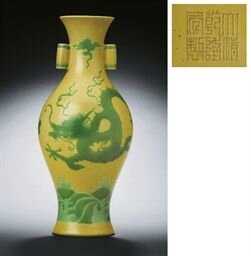The vase rising from a tapered foot to an oviform body before a gently waisted neck and trumpet mouth with a lipped rim, the exterior well carved and decorated with green enamel to depict a large scaly five-clawed dragon descending in pursuit of a 'flaming pearl', amidst scattered ruyi clouds and jagged flames, all against a bright yellow ground, wood stand, boxes.
Provenance: Collection of Sir Frank Swettenham, G.C.M.G., C.H., sold at Christie's London, 8th November, 1946, lot 192
The Montague Meyer collection sold at Sotheby's Hong Kong, 16 November 1988, lot 413
Note: This elegant vase with its long, slender neck, swelling body and flared foot is perhaps the most graceful of all the versions of the vase form called ganlan, or olive-shaped, in Chinese. This was a form that was admired in all three of the great imperial reigns of the Qing dynasty - Kangxi, Yongzheng and Qianlong. Interestingly, in contrast to the Kangxi attenuated form, the neck of later vessels appears to have become wider and shorter in the Yongzheng reign, and this trend continued into the reign of the Qianlong emperor, while similar vases without flare at either mouth or foot were also made.
Kangxi vases of this form are quite rare, but two are preserved in the Baur collection in Geneva. One of these has a light cobalt blue glaze over incised decoration, and is a little taller than the current yellow and green example (see John Ayers, Chinese Ceramics in the Baur Collection, Geneve, 1999, vol. 2, pp. 60-61, No. 182 [A328]. The other, which is somewhat smaller than the current vase, has shallow relief carving under a colourless glaze (see ibid., pp64-65, no. 185 [A411]. A typical Yongzheng example of the shape, quite closely following the current vase, is a blue and white vessel from the collection of the Palace Museum, Beijing (illustrated in The Complete Collection of Treasures of the Palace Museum 36 Blue and White Porcelain with Underglaze Red (III), Hong Kong, 2000, p. 93, no. 79). Two other Yongzheng examples from the Palace collection are published. One has a monochrome copper red glaze, and is illustrated in Qingdai yuyao ciqi, juan 1 xia, Beijing, 2005, pp. 38-9, no. 9, while the other, covered with a pale imitation Guan glaze, is illustrated in the same volume, pp 342-3, no. 157. The necks of these Yongzheng vases are, however, noticeably shorter and wider than those of the Kangxi examples, and the mouths are more flared. A vase of similar shape, but with tubular handles, similar colours and design to the current example is in the Palace Museum, Beijing, illustrated in Selected Porcelain of the Flourishing Qing Dynasty at the Palace Museum, Beijing, 1994, p. 349, no. 85. A pair of Qianlong vases of this latter type was sold in Christie's London rooms. 25 November, 1974, lot 212, and one was subsequently sold at Christie's Hong Kong, 27 may 2008, lot 1595 (image left).
Kangxi vases of the type represented in the current lot, would undoubtedly have provided the prototype for the later 18th century vases, despite the fact that the Qianlong examples have tubular lugs on either side of the neck, and have an additional band of waves in two tones of green around the foot. On the Kangxi example a large and powerful single dragon writhes around the whole body of the vessel, accompanied only by clouds, flames, and flaming pearl, while the length of the dragon on the Qianlong equivalent vase is reduced to allow the inclusion of a wave band around the foot .
The refined use of on-biscuit green enamel designs on yellow ground can be seen on a number of imperial porcelains from the Kangxi reign. Vases with dragon motif are very rare, but this design appears on a number of surviving open-wares. A bowl with everted rim bearing dragon, clouds and flaming pearl is among the porcelains from the imperial collection preserved in the Nanjing Museum (illustrated in Treasures in the Royalty - the Official Kiln Porcelain of the Chinese Qing Dynasty, Nanjing Museum eds., Shanghai, 2003, p. 73). A pair of Kangxi green and yellow straight-rimmed bowls decorated with dragon and phoenix is preserved in the collection of the Norton Museum of Art (illustrated in The Chinese Collection - Selected works from the Norton Museum of Art, West Palm Beach, 2003, pp. 208-9, no. 84). A Kangxi dish, decorated with green dragons and clouds on a yellow ground on the exterior, is in the collection of the Shanghai Museum (illustrated Kangxi Porcelain Wares from the Shanghai Museum Collection, Hong Kong, 1998, pp.304-5, no. 198), while the same collection has a Kangxi green and yellow dragon dish with scalloped edge (illustrated ibid., pp. 306-7, no. 199), similar to another scalloped dish in the Nanjing Museum (illustrated Treasures in the Royalty - the Official Kiln Porcelain of the Chinese Qing Dynasty, op. cit., p. 78). Although Kangxi vases decorated using green and yellow enamels on the biscuit are rare, there is a double-gourd vase, decorated with auspicious animals in landscape, in the collection of the Nanjing Museum (illustrated ibid, p. 90).
Christie's. The Imperial Sale Important Chinese Ceramics and Works of Art, 31 May 2010, Hong Kong

/https%3A%2F%2Fprofilepics.canalblog.com%2Fprofilepics%2F1%2F0%2F100183.jpg)
/https%3A%2F%2Fstorage.canalblog.com%2F03%2F02%2F119589%2F96711876_o.jpg)
/https%3A%2F%2Fstorage.canalblog.com%2F11%2F31%2F119589%2F94773502_o.jpg)
/https%3A%2F%2Fstorage.canalblog.com%2F20%2F83%2F119589%2F94772815_o.jpg)
/https%3A%2F%2Fstorage.canalblog.com%2F26%2F72%2F119589%2F75604929_o.jpg)
/https%3A%2F%2Fstorage.canalblog.com%2F59%2F60%2F119589%2F26458628_o.jpg)




/http%3A%2F%2Fstorage.canalblog.com%2F91%2F59%2F119589%2F128583044_o.jpg)
/http%3A%2F%2Fstorage.canalblog.com%2F00%2F16%2F119589%2F126318316_o.jpg)
/http%3A%2F%2Fstorage.canalblog.com%2F20%2F99%2F119589%2F111865967_o.jpg)
/http%3A%2F%2Fstorage.canalblog.com%2F66%2F81%2F119589%2F73444201_o.jpg)